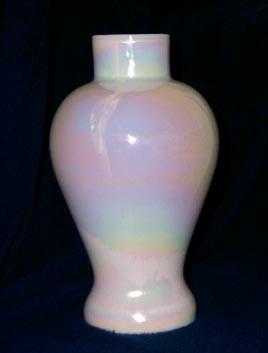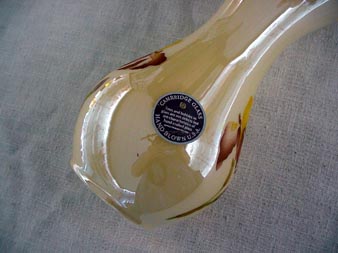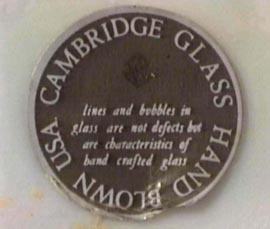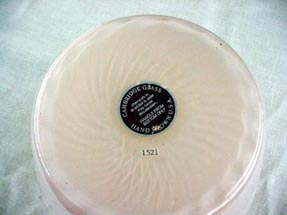National Cambridge Collectors, Inc.
A non-profit 501(c)(3) organization.

The OTHER Cambridge Glass
by Bud Walker
Issue No. 351 - July 2002
Editor's Note: This article gives great information about another company which bought the rights to the name "Cambridge Glass". The National Cambridge Collectors, Inc., and this website are not affiliated with this second company. This information is posted to help resolve the confusion that still exists regarding glass bearing these labels.
 On May 21, 2001, we found the
answer as to who was the last one to make glass and operate the
Cambridge Factory. It all began with a call from the Museum of American
Glass in Millville, New Jersey. One of the contemporary glass workers
had heard of an upcoming sale of molds, equipment, and contents of a
glass factory in Brooklyn, New York.
On May 21, 2001, we found the
answer as to who was the last one to make glass and operate the
Cambridge Factory. It all began with a call from the Museum of American
Glass in Millville, New Jersey. One of the contemporary glass workers
had heard of an upcoming sale of molds, equipment, and contents of a
glass factory in Brooklyn, New York.
I was called in an effort by the curator's office to learn what company was closing down. They had a phone number but had gotten no response. Gay Taylor, the curator, was in Corning, New York, and would not return until the following day. After making numerous attempts at calling the number that they had gotten, the phone was answered. The sale was to take place on May 22. Being a museum, we were invited to come on May 21 and preview the equipment that was to be sold. Knowing that very little was known about the Super Glass Company, we decided the trip to Brooklyn would be worthwhile.
Upon our arrival at the Brooklyn plant, we were greeted by Bonnie and Howard Friedman, the brother and sister who were handling the liquidation sale. Howard told us that his father was the founder and owner of the company and that he had passed away about six years ago and they had run the plant until its closing the previous year. They were forced to cease production due to the high cost of gas and a surge of cheap imports.
My reason for making the trip to Brooklyn was to try to learn more about the Super Glass/Cambridge connection. We were told that it all began when Super Glass had so many orders they needed to expand production and lacked the necessary space and the qualified workers in the Brooklyn area. Howard's father Bernie Friedman approached the Imperial Glass Company about doing contract work, merging or selling him the Imperial Company. Being unable to come to terms, Bernie purchased the old Cambridge factory. The only equipment left at the plant was the pot furnace. As Imperial had removed all the molds and equipment, the plant was an empty shell. According to Howard's best recollection, his father had four or five, five-ton day tanks installed and brought along his own lehr, molds, and tools, all of which were needed if they were to resume production.
By 1960, the plant was back in production making glass and would continue in operation for three or four years. Production ceased in 1963 or 1964. The reason his father decided to close the plant was given as continuous labor problems. Howard told us they had at least 20 wildcat strikes in the three or four years that they operated the factory. Most of the problems were caused by union organizers who would stop at Cambridge for breakfast on their way to West Virginia, and they would stir up the workers and then continue on their way. Another problem was many of the skilled glass workers had found employment with other glass companies. His father decided to close the factory and try to consolidate all of his glass making back at the Brooklyn plant.
According to Howard, they had purchased the name Cambridge Glass when they were in production at the plant. We were told that all the pieces of Super Glass with the round green paper label were made at the Cambridge Ohio factory. According to Howard Friedman, anyone who claims they didn't make glass at the Cambridge factory are dead wrong ... he should know as he worked in the plant and lived in Cambridge until his dad closed the plant.
The Friedmans made our trip to Brooklyn a huge success as we now know that the Super Glass Company made glass in their own molds at the Cambridge plant, and the story that they never made glass there is wrong. This story may have started due to the fact that the existing pot furnace was never used as all their glass was produced in the day tanks that Bernie had installed.
In addition to hearing the true story about Super Glass and their years in the Cambridge Glass factory. We enjoyed our tour of the Brooklyn factory and were able to purchase several optic molds in addition to several examples of the pieces they made while at Cambridge with the original labels still attached. In addition to lamp parts and enamel work, we now know that the beautiful vases and pieces with the round label had been made in the factory using their own molds. Super Glass Company made the last glass to leave the factory prior to the plant being razed.
Thanks to the Willard Kolb archives, we were able to verify that Bernie Friedman was in contact with the Imperial Glass Company as their minutes mentioned the ongoing effort to negotiate a possible sale of the company.
| Three Labels of the Super Glass Company | |
|---|---|
 |
CAMBRIDGE GLASS lines and bubbles in glass are not defects but are characteristics of hand crafted glass HANDLE FROM BOTTOM ONLY |
 |
CAMBRIDGE GLASS lines and bubbles in glass are not defects but are characteristics of hand crafted glass |
 |
CAMBRIDGE GLASS chemicals in, or added to water may cause discoloration HANDLE FROM BOTTOM ONLY |